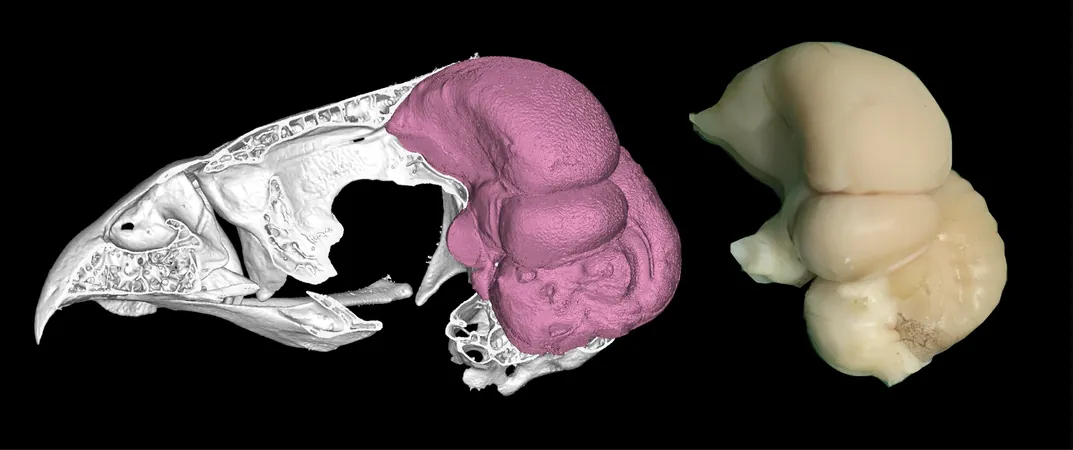
Revolutionary Findings Reveal Birds Are Smarter Than We Thought—Here's What the Science Says!
2025-01-22
Author: Arjun
Revolutionary Findings Reveal Birds Are Smarter Than We Thought—Here's What the Science Says!
Recent breakthroughs in avian neuroscience are overturning long-held misconceptions about bird intelligence. Often dismissed with the phrase "bird brain," these creatures are proving to possess cognitive abilities far more complex than previously imagined. Researchers from Australia and Canada have pioneered a groundbreaking study analyzing the brain structure of both extinct and contemporary bird species, unveiling intriguing insights into their mental capabilities.
The collaborative effort between evolutionary biologists at Flinders University in South Australia and neuroscience experts at the University of Lethbridge in Canada has resulted in what is now the largest study of its kind, encompassing 136 bird species. By employing advanced digital techniques, including computed microtomography, researchers have created detailed digital "endocasts," which are imprints of the brain's interior. These endocasts were derived from the cranial cavities of dry museum skulls, leading to remarkable revelations about the size and structure of birds’ brains.
The findings, published in the journal *Biology Letters*, are fascinating. The researchers discovered a striking correlation between the digital endocasts and the volume of crucial brain areas, the forebrain and cerebellum, suggesting that the physical space within a bird's skull can accurately reflect its brain proportions. "The correlation was nearly 1:1, which was beyond our expectations," shared lead author Aubrey Keirnan, a Ph.D. candidate at Flinders University. This breakthrough allows scientists to glean insights into the neuroanatomy of both rare and extinct species without the need for invasive procedures.
Prior to this technique, researchers often had to physically disrupt skulls to study their contents. "Now, we can create non-destructive digital endocasts from incredibly rare specimens," stated senior co-author Associate Professor Vera Weisbecker. This innovative approach not only preserves the physical integrity of valuable specimens but also enriches the scientific community's resource pool, with digital files available for wider academic use and public interest.
Professor Andrew Iwaniuk, a co-leader of the study, highlighted the unanticipated correlation between brain tissue and endocasts, noting challenges posed by the unique anatomical features of avian brains. "Despite the complexities, our findings provide a solid foundation for understanding the neuroanatomy of modern birds and offer insight into critically endangered species," he mentioned.
The implications of this study extend beyond contemporary birds; researchers are now considering how these methods may inform our understanding of dinosaurs, the closest extinct relatives of birds. However, Iwaniuk cautioned that while crocodiles are modern birds' closest living relatives, the brain structure variations might limit the applicability of this research to dinosaur species.
As scientists continue to untangle the complexities of avian intelligence, this study not only sheds light on bird cognition but also challenges stereotypes that have long persisted in our understanding of these remarkable creatures. The research marks a significant leap in the quest to comprehend animal intelligence and diversity, opening up new avenues for exploration in evolutionary biology and neuroscience.




 Brasil (PT)
Brasil (PT)
 Canada (EN)
Canada (EN)
 Chile (ES)
Chile (ES)
 Česko (CS)
Česko (CS)
 대한민국 (KO)
대한민국 (KO)
 España (ES)
España (ES)
 France (FR)
France (FR)
 Hong Kong (EN)
Hong Kong (EN)
 Italia (IT)
Italia (IT)
 日本 (JA)
日本 (JA)
 Magyarország (HU)
Magyarország (HU)
 Norge (NO)
Norge (NO)
 Polska (PL)
Polska (PL)
 Schweiz (DE)
Schweiz (DE)
 Singapore (EN)
Singapore (EN)
 Sverige (SV)
Sverige (SV)
 Suomi (FI)
Suomi (FI)
 Türkiye (TR)
Türkiye (TR)
 الإمارات العربية المتحدة (AR)
الإمارات العربية المتحدة (AR)